Content |
|---|
History
The Curly-coated Retriever It has existed since the late 18th century and is originally from the United Kingdom. It is the oldest Retriever type breed, and it is even believed that the first dog was used as a hunting dog.
Its exact origins are unclear., but he is believed to have many ancestors, as the Wetterhoun, the Irish Water Spaniel, the Newfoundland, the Barbet and races already extinct, as the “St. John's Newfoundland”, the “Old english spaniel”, the “Large rough spaniel”, the “Tweed Spaniel”, the “English spaniel” 16th century, the “Setter retriever” and the “Lesser newfoundland”. The curly hairs on his coat are the subject of debate among specialists: some say they are due to crossing with Poodle during the 19th century, while others argue that it owes them to Irish Water Spaniel o al Wetterhoun, and that Poodle it only improved the curls.
Bred to hunt birds, especially pheasants, quail and grouse, the Curly-coated Retriever could retrieve its prey from water or tall grass with great ease. They were highly prized by game rangers, who considered them perfect companions, and by Roma nomads, those who helped track the hunt. His great courage and sense of perseverance were highly appreciated and useful during hunting parties..
His first official appearance at a dog show was in 1860 in Birmingham (United Kingdom). Originally, the Curly-coated Retriever and the Flat-Coated Retriever were exhibited together as one dog. But, it soon became more and more common to display them separately, that is to say, as different races.
The Curly-coated Retriever reached their peak in the mid-19th century. They were highly prized by hunters and were even shipped in large numbers to New Zealand. (in 1889) and to Australia, especially to the areas near the Murray River, to carry out the same missions that were entrusted to them in the United Kingdom, but also sometimes to hunt kangaroos. Here, too, he did not fail to demonstrate his great courage and his formidable hunting skills.. But, The strong> Curly hair catcher of these territories were raised in a slightly different way than those of Europe, since breeders were looking for a finer morphology. Between the years 50 and 60, Australian breeders imported Darelyn Aristocrat, Sarona Simon, Banworth Simon, Banwort Athene y Pegasus, dogs that have been of great importance in the evolution of the breed, since they are still in the family tree of most of their local representatives.
In Europe, the breed was one of the first to be recognized by the Kennel Club (KC), which remains today the reference canine organization in the United Kingdom, after its creation in 1873. But, early twentieth century, the breed's popularity declined quite quickly, largely due to the arrival of the Labrador Retriever, that many hunters began to prefer. The conflicts of the first half of the 20th century did not help. After World War I, there were only a handful of people registered. Work was done to increase the number of registered hunters, but WWII soon ruined these efforts.
The Curly-coated Retriever arrived in the United States in 1907 hailing from the UK and the breed was recognized by the American Kennel Club (AKC) in 1924. But, remained quite rare in America, at least until the end of the decade 1960, when many specimens were imported from Australia, England and New Zealand, where the brood was most developed. The breed was accepted in 1960 by the United Kennel Club (UKC), the other reference canine organization in the country. But, until 1979 no breed club was created, the “Curly-Coated Club of America”, which highlights the relative lack of interest in race. But the breed remained rare in this territory, and it still is today. The same is true in Canada, where it was introduced shortly after.
It was also accepted by the Fédération Cynologique Internationale (FCI) in 1954.
In the news, the Curly-coated Retriever is the breed of “Retrievers” less represented in the world. Its total population is estimated at about 5.000 individuals, of which approximately 2.000 are in the United States. Occupies the position 160 (of something less than 200) in the breed classification established by the AKC based on the number of annual registrations in the organization.
In the United Kingdom, the KC records about 70 births per year. The exact figure sometimes varies significantly from year to year., but the trend has remained stable throughout 2010.
Less than in Australia, which is one of the countries with the largest contingent of representatives of the breed, since there he is still especially appreciated for his hunting skills. Since the middle of the first decade of the 21st century, a hundred dogs are registered each year in the Australian National Kennel Council (ANKC), the reference body of the country. But, This represents a decrease with respect to the figures observed since the mid-1990s. 1980 until the dawn of the new millennium and the beginning of the decade of 1990, when there were some 150 births per year, and even more than 200 in some years.
In France, the Curly-coated Retriever still very weird: since the years 90, with some exceptions, barely more than 10 copies per year in the Livre des Origines Français (LOF).
Physical characteristics
Sometimes it is confused with the “Labradoodle” (mix of Labrador Retriever and Poodle), the Curly-coated Retriever stands out above all for its fur decorated with many small curls. They are solid, always upright and with a body slightly longer than tall. Chest is deep, deep and deep, reaching to the elbows. Its upper line is very horizontal, their loins are short but strong. The neck is of medium length and opens to muscular, sloping shoulders.
The tail is a harmonious extension of the topline., that reaches the hocks. In general, carried straight and horizontal.
The front legs are straight, well placed under the body, and the rear ones are muscular. The legs are rounded and have webbed toes, which contributes to being an excellent swimmer.
The head is quite angular and has a skull the same length as the muzzle. The nose is the same color as the fur, that is to say, black or liver. The eyes are large and oval in shape. They are dark brown in black-coated dogs and any shade of brown in liver-coated dogs.. The ears are drooping and quite small.: reach a little above the eyes. The jaw is powerful and scissor-shaped., but no less delicate for that: this allows it to return its prey to the hunter without damaging its skin.
The coat of the Curly-coated Retriever is your brand. Has a black or brown fur (liver) solid formed by small curls that remain glued to the skin and cover the body from head to tail, although sometimes they are somewhat looser in the ears. The hair has a fairly soft texture but is very resistant, and provides excellent protection against water, the climate and vegetation. They are usually a little longer in the ears, the belly, the thighs, feet and legs. During the exhibitions, the hair on the tail is usually trimmed for purely aesthetic reasons. Last, does not have undercoat. On the other hand, their fur is usually somewhat oily, making you more likely to cause reactions in people with dog allergies.
Last, the breed is characterized by a fairly marked sexual dimorphism: not content with being bigger than female, the male is also noticeably more massive, with a much more developed musculature.
Size and weight
-
▷ Male size: Of 67 to 70 cm.
▷ Female size From 62 to 64 cm.
▷ Male Weight From 31 to 36 kg
▷ Female Weight From 31 to 36 kg
Varieties
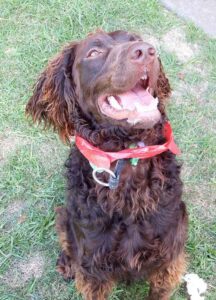
Since the 19th century there has been a smaller version of the Curly-coated Retriever, call “Murray River Curly-Coated Retriever”, but it is not recognized by canine organizations, incluido el Australian National Kennel Council (ANKC) from his native Australia.
Not all breeders of Curly-coated Retriever they have the same opinion: some consider him a distinct breed, while others see it simply as a variety of this type of “Retrievers”. But, DNA tests performed on 2010 they showed that the “Murray River Curly-Coated Retriever” is closer to Spaniels than Retrievers. In fact, is the result of the crosses between these two types of dogs: the American Water Spaniel, the Irish Water Spaniel, the “English Springer Spaniel”, the Chesapeake Bay Retriever and the Curly-coated Retriever.
Character and skills
The Curly-coated Retriever he is extremely endearing and is very attached to his family, to which he is very attached: wants to literally follow them everywhere from morning to night, without enjoying more than sharing their various activities.
Very playful regardless of age, gets along especially well with children, who are excellent playmates for him, and vice versa: they can spend hours together enjoying themselves in a happy and jovial atmosphere. He especially likes to search for and retrieve objects such as a ball, often to the delight of the little ones. So, it is clearly a recommended dog for children, but keep in mind that a dog should never be left with a small child without adult supervision. This is true for all races, but it is even more so with an animal of such size, since it is easy to push or even run over it by accident.
Although it is less demanding than the Labrador Retriever or the Smooth-haired Retriever, the Curly-coated Retriever need a good dose of daily physical activity. His owners must be able to allow him to exercise for at least one hour each day.
This can be done, of course, taking walks and playing with the children, but also, for example, practicing various sports for which it is especially indicated, like agility, the flyball or the discdog. The ob-rythmée allows you to show the quality of your education, and reinforce it at the same time.
It also, if a lake is found on the road during a walk, no hesitation in letting yourself take a dip in it: the Curly-coated Retriever feels like all Retrievers an undisguised pleasure to evolve in the water, and he is an excellent swimming dog.
In short, the need to exercise Curly-coated Retriever it is real, but it is not excessive, what makes it perfectly compatible, for example, with active retired people, who love to go for walks and find ways to let her get enough steam out each day if walks alone aren't enough.
This is especially true if they have, for example, a large garden in which you can run as you please. A house with a garden is also the best environment for a Curly-coated Retriever, since he likes to move outdoors. Thus, not really suitable for apartment living.
But, its place is not a niche at the bottom of a garden or in a park: the attachment to his family makes it difficult for him to bear being so far away from her. Has to evolve by your side, In the House.
It also, to the Curly-coated Retriever he does not like to be alone. Even though I appreciate dog puzzles, that keep you busy for a while and stimulate you intellectually, gets bored quickly in the absence of their masters, and may become noisy or develop destructive behaviors. So, not recommended for an owner who is away most of the day (for example, because of work) and that, therefore, can't spend a lot of time with your pet.
A solution to avoid loneliness is to have him share his daily life with another dog. He is very friendly and sociable with his companions, and thrives when in contact with them, which makes it an ideal option for a household that already has one or more dogs.
If you know him from a very young age, can also live very well with a rodent, a bird or a cat. But, there is often a difference between those you don't know and those you live with. Tends to confuse the former with prey, whereas normally there is no possibility of this happening with the seconds. So, despite being sociable with other human beings, Precautions should be taken during the first encounter between a Curly-coated Retriever and a cat, rodent or bird that is unknown to you.
If he Curly-coated Retriever is able to make his family happy and to integrate wonderfully into it, do not be fooled: Your ride is not like a long calm river. In fact, although at first glance it seems very easy to live with him and he is a close cousin of the Golden Retriever and of the Labrador Retriever, who are reputed to be races “easy”, not as easy to handle as they.
In fact, sometimes he can be somewhat distant and indifferent to orders. Being very smart, they like to judge what is good for them and what is not, and they are more independent than their cousin the labrador. For this reason, sometimes it's hard to get their attention when you've decided you don't like an exercise, for example.
It is also a dog that matures slowly, so you have to be patient at first. It also, if used for hunting, it is quite vain to expect me to work before 2 or 3 years, because he is not very efficient during his prolonged period of adolescence. But, knows how to compensate later, showing its great qualities as a working dog: armed with a very strong determination, don't give in until homework is done.
While waiting for the threshold at which you have reached -finally- Adulthood, what is around 3 years, sustained training is necessary to be obedient, and also to try to make it less destructive. In fact, during all this time, far from being the wisest, since it has a tendency to tip over and, above all, to chew everything in its path. In fact, any fragile or valuable object should be kept out of their reach. Nor should we be surprised to see him walking with slippers or cushions: be destined to inform for centuries, take objects in the mouth and move them (potentially degrading them in the process) it's literally without your genes. At the beginning, it may also be wise to give access to only a few rooms in the house, thus limiting breakage. You should also offer him toys that he can easily damage, to try to direct your attention to objects that are safe. You can also bite the hands of those around you.
Distrustful of strangers, he is shy at first with the guests, although he verifies that his master welcomes them very positively. On the other hand, when faced with a human being who is obviously unwelcome, he is quite protective and even impressive, and won't stop barking loudly to deter the intruder. It is an excellent watchdog.
On the other hand, if you are balanced and capable enough to exercise, not especially loud, and only uses his voice to warn of the arrival of a stranger.
Observations
The Curly-coated Retriever, It is a rare watch dog and find, both in their country of origin and in the rest of the world.
A key characteristic in his character, unlike other Retrievers, is that he is usually very reñidor with other dogs, and that can that he has hindered its spread…
Education
To the Curly-coated Retriever fundamentally loves to learn; once you are motivated, training sessions are a pure pleasure, and progresses exponentially.
But, this motivation does not come naturally, since he has a tendency to judge for himself the interest of each of the exercises that are proposed to him. If you are not convinced by the day's activity, does not stop letting you know, in particular being ostensibly distant; So, sometimes it's hard to get their attention. You also need variety, so it is necessary to be able to regularly introduce something new to keep it receptive: if the same exercises are always suggested, gets bored quickly and shifts attention to something else. The owner's mood also influences their dog's motivation: a smiling and cheerful attitude makes you much more willing to listen and work. He is also very receptive to positive reinforcement methods., that are based on the use of all kinds of rewards (compliments, candies, petting) to encourage you to give your best.
You need a teacher who is not only intelligent and enthusiastic, but have some confidence in yourself, capable of instilling in him a good working base and the limits that he should not cross. If that is not the case, your great intelligence can lead you to win the game.
One of the main trends you should try to address is the puppy's propensity to engage in destructive behavior and, in particular, to bite and nibble everything that is put in the mouth. In principle, this disappears in adulthood, but it may be wise to suppress this type of behavior when caught on the spot, in an attempt to limit the phenomenon. This is especially true when taking it out on family members, with both adults and younger children: may look pretty and harmless when they are still very young, but it can be much more dangerous once they are adults.
This is especially helpful, since the Curly-coated Retriever takes a while to become an adult, and can be immature to a fairly old age. These may include, some dogs used for hunting are not really trained to go out into the field and be really effective at it until the 3 years of age. So, it is necessary to have some patience and understanding in the first years of life…
In any case, individuals destined to have sex in water must get used to entering and evolving in water as soon as possible. Usually, this is not a problem, since representatives of this breed are naturally attracted to water points, but they move more easily since they swim in them since they are very young. They must also be taught their future role as hunters and rapporteurs. To the extent that they carry it in their genes, it is not a major difficulty, but you have to teach them to do it under the orders of their owner, so that they do not harm the prey when catching it.
Last, like any dog, the Curly-coated Retriever must benefit from great socialization work started at a very young age. This is all the more necessary since they often tend to distrust strangers. So, it is necessary to make him know all kinds of humans and other animals (both congeners and representatives of other species), but also expose him to all kinds of stimuli (noises, smells…) and environments. This helps them feel comfortable in any circumstance and prevents negative reactions such as stress., fear or distrust in the face of what is unknown to them. A well socialized puppy lives much better with humans.
Health
In general, the Curly-coated Retriever is in good health.
Besides having an original look, its coat is highly waterproof and protects it from inclement weather and especially low temperatures.
But, is more exposed to certain potential problems:
- The Hip Dysplasia, which affects most large dogs and is usually hereditary. The femur does not fit perfectly into the pelvic socket of the hip joint; some individuals show no symptoms, but others suffer pain and lameness. Osteoarthritis can also develop over time as the animal ages;
- elbow dysplasia, also hereditary and common in large dogs, especially in Retrievers. This developmental abnormality of the elbow affects one or both front legs and causes lameness., often even before the puppy is one year old. Usually requires surgical intervention;
- Dilatation-torsion of the stomach, a serious syndrome that affects large dogs with deep chests, as the Curly-coated Retriever. The animal dies quickly if a veterinarian is unable to intervene quickly ;
- The type III glycogenosis, which consists of an excessive accumulation of glycogen in the liver and muscles. Provokes, among other things, weakness, rigidity, exercise intolerance, increased need for sleep and difficulty swallowing. It is incurable and leads to the death of the dog around the 2 years of age;
- The epilepsy, which is the result of excessive electrical activity in the brain and leads to short and more or less regular seizures. With good veterinary care and the use of appropriate medication, normally does not prevent the animal from leading a normal life ;
- The alopecia, that is to say, refined and progressive hair loss in various parts of the body, according to different possible patterns. Do not let the dog spend a long time lying on hard and rough surfaces, like concrete, helps limit the problem.
Like all Retriever-type dogs, the Curly-coated Retriever you also have an increased risk of developing tumors and other cancers. In fact, it is the main cause of death in this breed, long before old age, According to a study carried out jointly in 2004 by the British Kennel Club and the British Small Animal Veterinary Association. More concretely, the most common forms of cancer seen in this breed are :
- The linfosarcoma, one of the most common cancers of all races. It can appear in various parts of the body, like spleen, the gastrointestinal tract, lymph nodes, the liver and bone marrow. Treatment is by chemotherapy, sometimes in addition to surgery. Referral rates are pretty good;
- The adenocarcinoma, which is the development of malignant cells most often from the uterus, mammary glands and intestines. Most of the time, these cells spread to the lungs or anus. Surgery is often used to treat this disease.;
- The fibrosarcoma, a tumor that can affect any part of the body, including bones. surgery is inevitable, and sometimes chemotherapy is required, immunotherapy or radiation therapy. The prognosis for recovery varies greatly from case to case.;
- The mast cell tumors, which are the most common in the skin of dogs. Most often they form on the legs, around the anus or on the chest, but they can also arise towards the head or neck. Treatment varies from case to case, but usually includes surgery and chemotherapy;
- The melanoma is a cancer that affects the cells that produce pigments in the skin, called melanocytes. Although most melanomas are found on the skin, They can also develop on the gums, and treatment may require amputation of part of the jaw. Usually treated with surgery and chemotherapy;
- The hemangiosarcoma, a form of malignant cancer found in the lining of blood vessels and in the spleen. Can be treated with surgery and chemotherapy, but the affected animal is unlikely to recover;
- The osteosarcoma, a bone cancer that initially causes lameness. Usually entails amputation of the affected leg and heavy chemotherapy. It is very rare to be able to survive this disease, as the problem is often diagnosed too late. Once identified, the affected person may live between 9 months and 2 years longer than if it had not been treated.
Once identified, an affected dog can live between 9 months and 2 years longer than if it had not been attended.
Last, the breed is also especially prone to eye problems, as :
- The entropion, corresponding to a defect that rolls the eyelid inward, causing irritation of the eyeball. Both eyes may be affected or only one; in both cases, surgical intervention can be performed to remedy the problem;
- The ectropion, a curl defect of the lower eyelid. The lower eyelid then does not perform its function of protecting the eye, which makes you more susceptible to irritation or conjunctivitis. Surgery is used to treat the most severe cases;
- The distiquiasis, an abnormality in the implantation of eyelashes on the eyelids that can cause irritation of the eye and even the development of corneal ulcers;
- Persistent pupillary membrane, when the dog's pupillary membrane stays in place, while normally it is supposed to disappear during its first 6 months. The dog's vision is usually slightly affected;
- The cataract, that can affect one or both eyes and cause partial or total opacity of the same. At the beginning, cataracts cause very little damage to the dog's vision, but they end up causing total blindness when they reach a more advanced stage. Surgery can fix it;
- Progressive retinal atrophy, a family of incurable eye diseases that cause progressive deterioration of the retina. At the beginning, those affected have difficulty seeing at night, but as the disease progresses, the dog ends up going totally blind;
- the retinal dysplasia, a malformation of the retina that can cause, in the most serious cases, a detached retina and, Therefore, dog blindness.
It also, individuals who are engaged in hunting -and, in general, everyone who spends a lot of time outdoors- are more at risk of injury, but also parasites and spikes, that those who are only meant to keep company.
Last, the Curly-coated Retriever have a significant predisposition to gain weight. So, a certain vigilance is necessary in this matter, since obesity can, just like in humans, cause or aggravate many health problems.
In view of the large number of hereditary diseases to which the breed is exposed, go to a serious breeder of Curly-coated Retriever it is essential to maximize the chances of adopting a healthy animal free from such defects. In addition to the results of the genetic tests carried out on the parents and / or the puppy, the professional must be able to provide a certificate of good health established by a veterinarian, as well as the data of the administered vaccines, registered in the dog's health or vaccination card.
From then on, as for any race, the best way to keep you in good health is to invest in prevention. It is especially important that your dog is examined at least once a year by a veterinarian: as well as making sure you are up to date on your vaccinations, This can help you quickly spot a potential problem and remedy it before it becomes too serious..
Life expectancy
The life expectancy average of Curly-coated Retriever, is of 14,9 years, Although there are cases of dogs who have lived up 15 or 17 years of age.
Grooming
Contrary to what you might think at first glance, the maintenance of the coat of the Curly-coated Retriever it's not especially complicated. A weekly brushing is enough, but special attention should be paid to the hair on the legs, the tail and behind the ears, as it is especially dense and knots easily. In general, they lose very little hair, except during the molting period, in spring and autumn: then it is necessary to increase the frequency of brushing, to avoid finding too much hair all over the house.
These periods are also a good opportunity to bathe your dog., taking care to use a shampoo specially designed for dogs every time. In general, two bathrooms a year are enough, although, of course, do not hesitate to wash the dog when it is especially dirty. In any case, it is useless to dry it after the bath, since her hair dries very quickly. It also, your curls could be completely denatured.
As the risk of eye diseases is quite pronounced in the Curly-coated Retriever, your eyes should be maintained carefully and on a regular basis. They should be checked and cleaned with clean water at least once a week.
His ears are not for less, as his droopy form means he is more prone to developing infections at this level (ear infections, etc.). So, rigorous maintenance also needs to be done every week, to remove any dirt and moisture that may have accumulated. It also, to avoid the latter, it is recommended to dry them systematically every time they come out of the water.
Your weekly maintenance session is also an opportunity to brush your teeth with a toothpaste designed for cats.. This helps to avoid the formation of tartar and the health problems that it can lead to as much as possible.. Ideally, do it more often than once a week, or even daily.
Their claws require much less attention, especially in subjects who spend a lot of time outdoors. Natural wear and tear is usually enough to file them. But, it is advisable to remain vigilant and check from time to time that it is not necessary to cut them by hand. This is so as soon as they touch the ground, that is to say, when you hear its rattle on hard surfaces; otherwise, they could not only annoy you, but also break, at the risk of hurting you.
Regular coat care, the eyes, the ears, teeth and claws should be done delicately, rigor and precision. The first time, don't hesitate to ask a vet or groomer to show you how to do it, to learn the proper gestures. It also, accustoming your dog from a young age allows him to consider these manipulations as something normal, and that these moments take place with tranquility and good humor.
It also, it helps to take a little time to examine your dog when you return from hunting or spending a lot of time outdoors (especially in a place with a lot of vegetation, like a forest). In addition to a possible injury, this may reveal the presence of spikelets, ticks or other parasites that may have attached to the dog. In fact, they are likely to cause problems in the short to medium term, sometimes serious or even fatal.
Utility
The Curly-coated Retriever was originally created and developed as a hunting dog, especially to recover prey -especially birds- from hard-to-reach areas such as ponds and tall grass.
Today it continues to fulfill this function., and in some countries, like New Zealand, this is its main use.
But, the most common is to find him as a family companion, since he always gets along very well with children and loves to follow his masters everywhere. But, it should be able to satisfy your need for a lot of exercise, which makes it an excellent option for athletes.
Very athletic and eager to learn, can excel in many dog ​​sports disciplines, starting with agility, the flyball, the discdog, obedience and prescription.
Your distrust of strangers, its propensity to bark loudly and its size also make it an effective watchdog.
Price
The Curly-coated Retriever he is the hardest retriever to find.
In Europe, it is even a very rare breed of dog, except in your country of origin. There are only a handful of breeders outside the country of origin, and prices usually range from 900 and 1200 EUR. But, sometimes you have to wait a long time on the waiting list…
One solution may be to look in the UK to adopt a puppy from Curly-coated Retriever, since the offer is much wider. The cost of adopting a puppy from Curly-coated Retriever in the UK it is much higher. The normal cost ranges from 600 and 800 sterling (700 and 900 EUR), plus the cost of paperwork and transportation. It also, in that case, It is advisable to find out about the regulations regarding the importation of a dog from abroad and to respect them.
whatever the country, the price depends, as for any dog, of brood fame, the prestige of the lineage from which it comes and, of course, its intrinsic characteristics, especially physical.
Characteristics "Curly-coated Retriever"
Coexistence is important that you have with your new friend. Before considering the acquisition of a dog of the breed "Curly-coated Retriever" you know certain factors. Not all breeds of dogs are apt to live in an apartment, you must take into account his character, their need for exercise, their interaction with other pets, their care and if you have small children, their level of tolerance towards them.
Adaptation ⓘ3.0 out of 5 stars (based on 1 review)
|
friendly dog ⓘ4.0 out of 5 stars (based on 1 review)
|
hair loss ⓘ3.0 out of 5 stars (based on 1 review)
|
|---|---|---|
Affection level ⓘ5.0 out of 5 stars (based on 1 review)
|
Need for exercise ⓘ3.0 out of 5 stars (based on 1 review)
|
Social need ⓘ3.0 out of 5 stars (based on 1 review)
|
Home ⓘ3.0 out of 5 stars (based on 1 review)
|
Toilet ⓘ2.0 out of 5 stars (based on 1 review)
|
Friendly with strangers ⓘ3.0 out of 5 stars (based on 1 review)
|
barking ⓘ3.0 out of 5 stars (based on 1 review)
|
Health ⓘ3.0 out of 5 stars (based on 1 review)
|
Territorial ⓘ3.0 out of 5 stars (based on 1 review)
|
Cat friendly ⓘ3.0 out of 5 stars (based on 1 review)
|
Intelligence ⓘ4.0 out of 5 stars (based on 1 review)
|
Versatility ⓘ3.0 out of 5 stars (based on 1 review)
|
Child friendly ⓘ4.0 out of 5 stars (based on 1 review)
|
Surveillance ⓘ3.0 out of 5 stars (based on 1 review)
|
joy ⓘ3.0 out of 5 stars (based on 1 review)
|
Images “Curly-coated Retriever”
Videos “Curly-coated Retriever”
Type and recognitions:
- FCI CLASSIFICATION: 110
- Group 8: Retrievers - Flushing Dogs - Water Dogs
- Section 1: Retrievers. With proof of work..
Federations:
- – FCI – Group 8: Retrievers - Flushing Dogs - Water Dogs – Section 1: Retrievers ⓘ
- – AKC – Sporting ⓘ
- – ANKC – Group 3 (Gundogs) ⓘ
- – CKC – Sporting Dogs ⓘ
- – KC – Gundog ⓘ
- – NZKC – Gundog ⓘ
- – UKC – Gun Dogs ⓘ
FCI breed standard "Curly-coated Retriever"
Alternative names:
1. Curly (English).
2. Curly (French).
3. kraus gelockter Retriever (German).
4. Curly (Portuguese).
5. Retriever de pelo rizado, Curly, CCR, (en inglés: Curly Coated Retriever) (español).
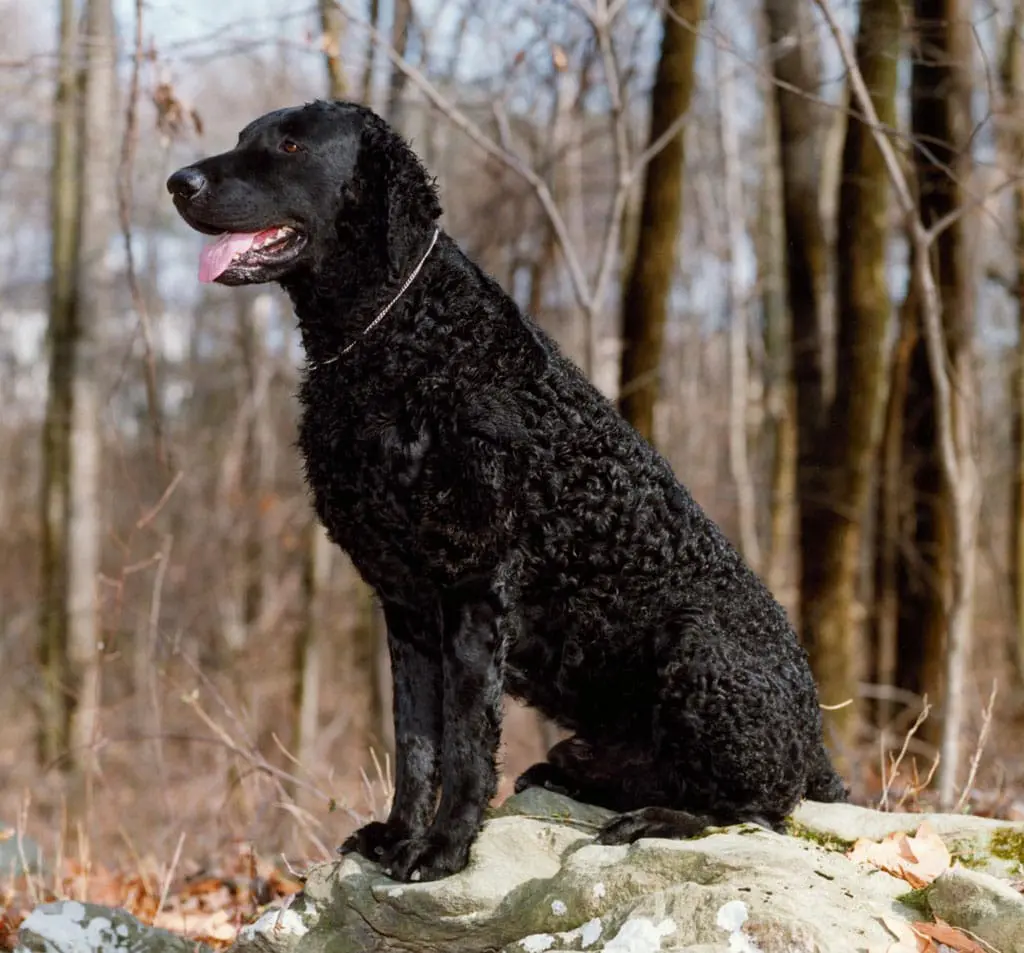
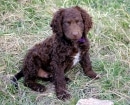
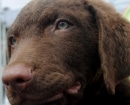

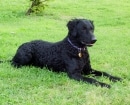
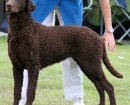
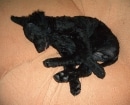
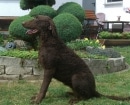
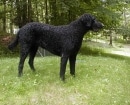
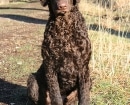
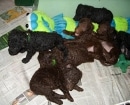

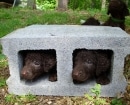
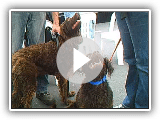 Murray River Curly Coated Retrievers
Murray River Curly Coated Retrievers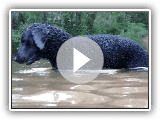 Curly Coated Retriever swimming
Curly Coated Retriever swimming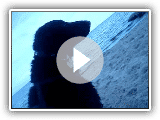 curly coated retriever Balto at the beach:)
curly coated retriever Balto at the beach:)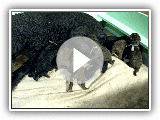 Curly-Coated Retriever Puppies
Curly-Coated Retriever Puppies